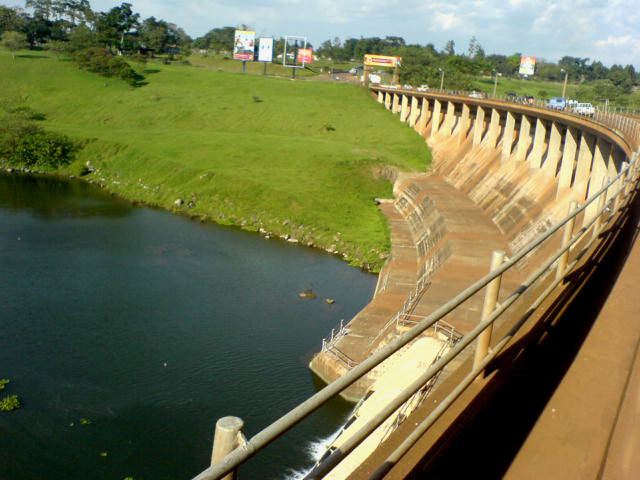Purpose Power Opening date 1954 Opened 1954 | Status Operational | |
 | ||
Similar Owen Falls, Bujagali Hydroelectric Power St, Ripon Falls, Bujagali Falls, Isimba Hydroelectric Power St | ||
Nalubaale Power Station, formerly known as Owen Falls Dam, is a hydroelectric power station across the White Nile near to its source at Lake Victoria in Uganda. Nalubaale is the Luganda name for Lake Victoria.
Contents
- Map of Owen Falls Dam Uganda
- Location
- History
- Operations
- Owen Falls Extension
- Lake Victoria water levels
- References
Map of Owen Falls Dam, Uganda
Location
The dam sits across the Nile River between the town of Jinja, in Jinja District and the town of Njeru in Buikwe District, approximately 85 kilometres (53 mi), by road, east of Kampala, Uganda's capital and largest city.
History
In 1947, Charles Redvers Westlake, an English engineer, reported to the Colonial Government of Uganda recommending the construction of a hydroelectric dam at Owen Falls near the city of Jinja. This led to the establishment of the Uganda Electricity Board (UEB), with Westlake as its first chairman. The consultant engineer on the project was Sir Alexander Gibb & Partners. The dam was completed in 1954, submerging Ripon Falls. It supplies electricity to Uganda and parts of neighbouring Kenya and Tanzania. Maintenance and availability of the station declined seriously during the government of Idi Amin.
Before the construction of the dam, water levels on Lake Victoria were moderated by a natural rock dam on the north side of the lake. Rising lake waters would spill over the natural dam into the White Nile, which flows through Uganda, South Sudan, Sudan, and Egypt before emptying into the Mediterranean Sea. When water levels dropped too low, flow into the river ceased. When the current dam was built, a treaty between Uganda and Egypt ensured that the natural flow of the Nile would not be altered by the dam.
The rating of the Nalubaale power station is 180 megawatts (MW). Originally it was designed for ten turbines rated at 15 megawatts (20,000 hp) each (a total of 150 megawatts (200,000 hp)). The station was refurbished in the 1990s to repair the accumulated wear from a decade of civil disorder. During the repairs, the output power of the generators was increased, bringing the Nalubaale Power Complex's generating capacity to 180 megawatts (240,000 hp).
Operations
The Uganda Government, through the Uganda Electricity Generation Company (UEGCL), a 100% parastatal, awarded a 20-year operational, management and maintenance concession to Eskom Uganda Limited, a subsidiary of Eskom, the South African energy company, to cover both Nalubaale Power Station and the adjacent Kiira Power Station. The concession agreement commenced in 2002. The electricity generated here, is sold to the Uganda Electricity Transmission Company Limited (UETCL), the authorized single buyer. UETCL in turn sells the power to Umeme, the energy distributor.
Owen Falls Extension
In 1993 work started on the Owen Falls Extension project, a second powerhouse located about 1 km from the 1954 powerhouse. A new power canal was cut to bring water from Lake Victoria to the new powerhouse. Major construction was completed in 1999 with first power from the project from two units in 2000. The extension has space for five hydroelectric turbine generators with four installed as of 2001. Each unit at the extension has a capacity of 40 megawatts. During official opening ceremonies in 2003, the extension was named the Kiira Power Station. Design and project management of the extension project was by Acres International of Canada, now known as Hatch Limited.
ESKOM Uganda operates Nalubaale Power Station as a concessionaire. They regularly clear debris water hyacinth from the intakes of the stations. Further downstream, the 250 MW Bujagali Hydroelectric Power Station was constructed between 2007 and 2012.
Lake Victoria water levels
Since January 2006, hydroelectric generation at Nalubaale and Kiira stations has been curtailed due to a prolonged drought and low level of water in Lake Victoria. The hydrology of Lake Victoria has unusual features.
In 2006 there was a release of secret documents from 1956 in Britain that indicated the British had considered using this dam to reduce the water in the Nile in an effort to remove Egyptian President Nasser. The plan was not carried out because it would have seasonally flooded land in Kenya, Uganda and Tanzania, reduced flows to a trickle in Sudan and the effect of shutting off the White Nile even to coincide with the seasonal lull in the Blue Nile would not have affected Egypt for at least 16 months. Veto power over construction projects on the Nile River and its tributaries was granted to Egypt by the Anglo-Egyptian treaty of 1929, reinforced by the bilateral agreement between Egypt and Sudan signed in 1959. In 1959 upriver Nile states such as Uganda denounced this treaty purportedly claiming virtually all of the waters of the Nile to themselves and leaving none to the upriver states. The countries along the White Nile excluding Sudan seek to create a unified international legal framework for the basin and for the time being respect keeping lake levels virtually unaltered so as not to upset their own eco-systems and established patterns of crop production and livestock raising.
